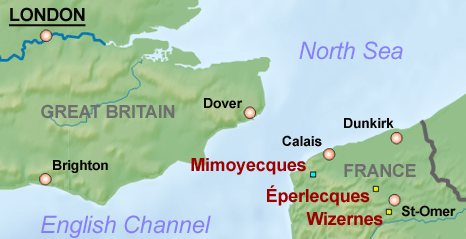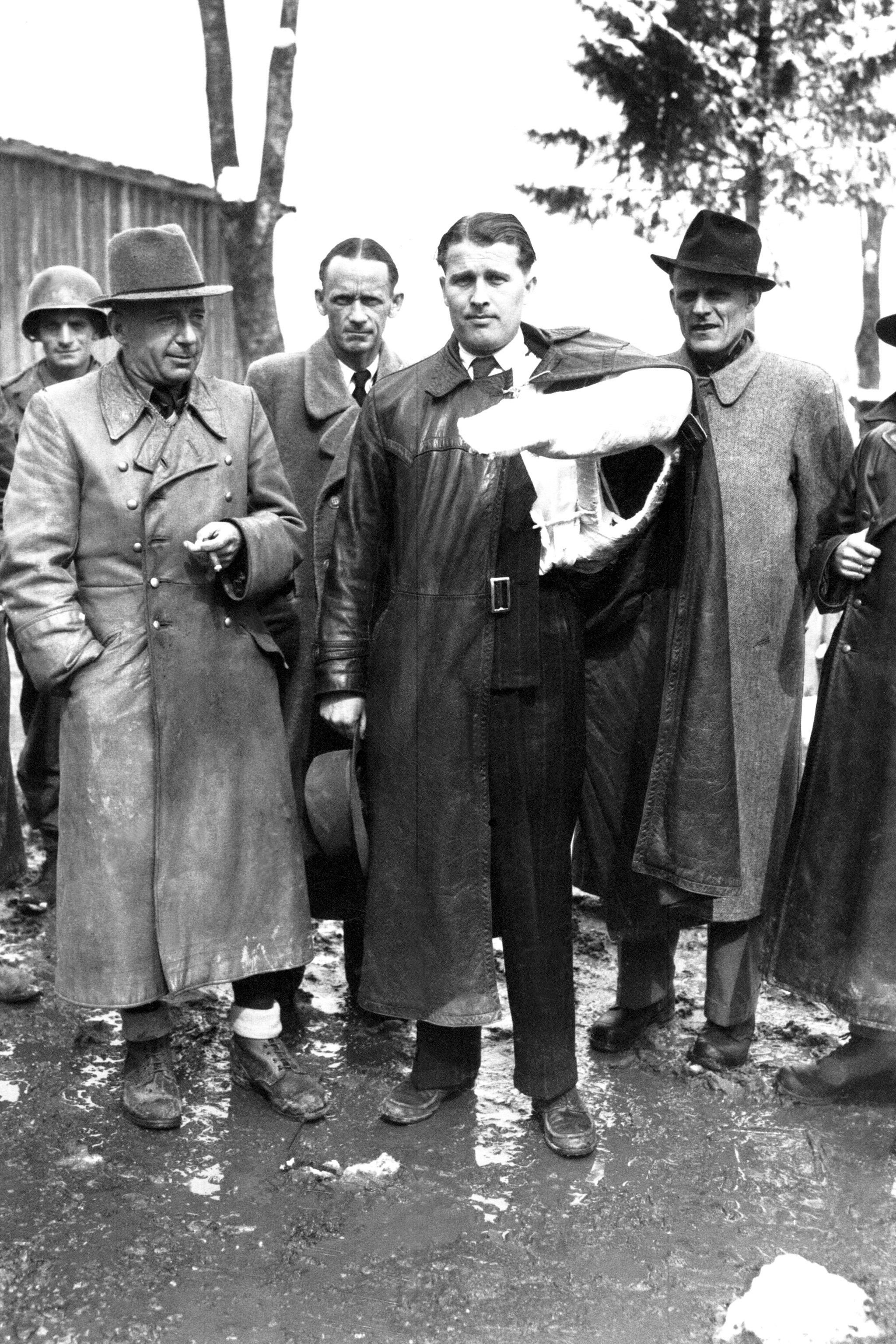|
Sottevast V2 Bunker
Sottevast was a Second World War bunker complex for launching V2-weapons in Sottevast near Cherbourg, in Normandy, France. It was built, under the codename Reservelager West (Reserve Store West), by the forces of Nazi Germany between 1943 and 1944 to serve as a launch base for V-2 rockets directed against southern England. The bunker was never completed as a result of the bombings by the British and United States air forces as part of Operation Crossbow against the German V-weapons program and the Normandy landings in June 1944. Background The V-2 rocket (german: Vergeltungswaffe 2, link=no, "Retribution Weapon 2") one of several innovative long-range weapons developed by the Germans after the failure of the Luftwaffe to strike a decisive blow against Britain. The missile, powered by a liquid-propellant rocket engine, was developed during the Second World War in Germany as a "vengeance weapon", assigned to attack Allied cities as retaliation for the Allied bombings agains ... [...More Info...] [...Related Items...] OR: [Wikipedia] [Google] [Baidu] |
Sottevast
Sottevast () is a commune in Normandy in north-western France. Sottevast in World War II During World War II, there was a German storage and servicing bunker for V-weapons near Sottevast. The site was captured by the 504th Parachute Infantry Regiment of the 82nd Airborne Division during the Normandy campaign Operation Overlord was the codename for the Battle of Normandy, the Allied operation that launched the successful invasion of German-occupied Western Europe during World War II. The operation was launched on 6 June 1944 (D-Day) with the Norm .... References Communes of Manche Ruins in Normandy V-weapon subterranea World War II strategic bombing {{Manche-geo-stub ... [...More Info...] [...Related Items...] OR: [Wikipedia] [Google] [Baidu] |
La Coupole
''La Coupole'' ( en, The Dome), also known as the ''Coupole d'Helfaut-Wizernes'' and originally codenamed ''Bauvorhaben'' 21 ('Building Project 21') or ''Schotterwerk Nordwest'' (Northwest Gravel Works), is a Second World War bunker complex in the Pas-de-Calais '' department'' of northern France, about from Saint-Omer, and some 14.4 kilometers (8.9 miles) south-southeast from the less developed Blockhaus d'Eperlecques V-2 launch installation in the same area. It was built by the forces of Nazi Germany between 1943 and 1944 to serve as a launch base for V-2 rockets directed against London and southern England, and is the earliest known precursor to modern underground missile silos still in existence. Constructed in the side of a disused chalk quarry, the most prominent feature of the complex is an immense concrete dome, to which its modern name refers. It was built above a network of tunnels housing storage areas, launch facilities and crew quarters. The facility was designed to ... [...More Info...] [...Related Items...] OR: [Wikipedia] [Google] [Baidu] |
Walter Dornberger
Major-General Dr. Walter Robert Dornberger (6 September 1895 – 26 June 1980) was a German Army artillery officer whose career spanned World War I and World War II. He was a leader of Nazi Germany's V-2 rocket programme and other projects at the Peenemünde Army Research Centre. Dornberger was born in Gießen and enlisted in 1914. In October 1918, as an artillery lieutenant Dornberger was captured by United States Marines and spent two years in a French prisoner of war camp, mostly in solitary confinement because of repeated escape attempts. In the late 1920s, Dornberger completed an engineering course with distinction at the Berlin Technical Institute, and in the Spring of 1930,Dornberger's detailed account of the V2 project was one of the first to be published by a major participant. Dornberger graduated after five years with an MS degree in mechanical engineering from the '' Technische Hochschule Charlottenburg'' in Berlin. In 1935, Dornberger received an honorary doc ... [...More Info...] [...Related Items...] OR: [Wikipedia] [Google] [Baidu] |
Le Molay-Littry
Le Molay-Littry () is a commune in the Calvados department in the Normandy region in northwestern France. History On 23 January 1969 Le Molay (the old INSEE code was 14434) merged with the old commune of Littry to form ''Le Molay-Littry'', which uses the old Littry INSEE code 14370. Le Molay-Littry has good travel links with neighbouring towns such as Isigny, Bayeux, Saint-Lô, and Balleroy, which served it well in the early 17th century. At that time, the town was a local source of coal which made the town a wealthy one. The town still has a mining museum which is open to the public. Chateau du Molay The Chateau du Molay was built on the northwest side of town about two and a half centuries ago in 45 acres of wooded grounds. In 1758, a young Jacques-Jean le Coulteux du Molay (1740–1823), equerry to King Louis XV, and his wife Geneviéve –Sophie le Coulteux de la Noraye (painted below in 1788); built the chateau, his first large residence, in the heart of Normandy's wo ... [...More Info...] [...Related Items...] OR: [Wikipedia] [Google] [Baidu] |
Chiefs Of Staff Committee
The Chiefs of Staff Committee (CSC) is composed of the most senior military personnel in the British Armed Forces who advise on operational military matters and the preparation and conduct of military operations. The committee consists of the Chief of the Defence Staff who is the chairman and professional head of the forces, the Vice-Chief of the Defence Staff, who is the vice-chairman and deputy professional head of the armed forces. The committee also consists of the professional heads of each branch of the armed forces: the First Sea Lord and Chief of the Naval Staff, the Chief of the General Staff and the Chief of the Air Staff. History The Chiefs of Staff Committee was initially established as a sub-committee of the Committee of Imperial Defence in 1923. It remained as such until the abolition of the CID upon the outbreak of World War II in 1939. The initial composition of the committee was the professional heads of the three services, the First Sea Lord, the Chief of the ... [...More Info...] [...Related Items...] OR: [Wikipedia] [Google] [Baidu] |
Pas-de-Calais
Pas-de-Calais (, " strait of Calais"; pcd, Pas-Calés; also nl, Nauw van Kales) is a department in northern France named after the French designation of the Strait of Dover, which it borders. It has the most communes of all the departments of France, 890, and is the 8th most populous. It had a population of 1,465,278 in 2019.Populations légales 2019: 62 Pas-de-Calais INSEE The Calais Passage connects to the on the . Pas-de-Calais borders the departments of [...More Info...] [...Related Items...] OR: [Wikipedia] [Google] [Baidu] |
Adolf Hitler
Adolf Hitler (; 20 April 188930 April 1945) was an Austrian-born German politician who was dictator of Nazi Germany, Germany from 1933 until Death of Adolf Hitler, his death in 1945. Adolf Hitler's rise to power, He rose to power as the leader of the Nazi Party, becoming the Chancellor of Germany, chancellor in 1933 and then taking the title of in 1934. During his dictatorship, he initiated European theatre of World War II, World War II in Europe by invasion of Poland, invading Poland on 1 September 1939. He was closely involved in military operations throughout the war and was central to the perpetration of the Holocaust: the genocide of Holocaust victims, about six million Jews and millions of other victims. Hitler was born in Braunau am Inn in Austria-Hungary and was raised near Linz. He lived in Vienna later in the first decade of the 1900s and moved to Germany in 1913. He was decorated during his Military career of Adolf Hitler, service in the German Army in Worl ... [...More Info...] [...Related Items...] OR: [Wikipedia] [Google] [Baidu] |
Strategic Bombing During World War II
World War II (1939–1945) involved sustained strategic bombing of railways, harbours, cities, workers' and civilian housing, and industrial districts in enemy territory. Strategic bombing as a military strategy is distinct both from close air support of ground forces and from tactical air power. During World War II, many military strategists of air power believed that air forces could win major victories by attacking industrial and political infrastructure, rather than purely military targets. Strategic bombing often involved bombing areas inhabited by civilians, and some campaigns were deliberately designed to target civilian populations in order to terrorize them and disrupt their usual activities. International law at the outset of World War II did not specifically forbid the aerial bombardment of cities – despite the prior occurrence of such bombing during World War I (1914–1918), the Spanish Civil War (1936–1939), and the Second Sino-Japanese War (1937–1945 ... [...More Info...] [...Related Items...] OR: [Wikipedia] [Google] [Baidu] |
Liquid-propellant Rocket
A liquid-propellant rocket or liquid rocket utilizes a rocket engine that uses liquid rocket propellant, liquid propellants. Liquids are desirable because they have a reasonably high density and high Specific impulse, specific impulse (''I''sp). This allows the volume of the propellant tanks to be relatively low. It is also possible to use lightweight centrifugal turbopumps to pump the rocket propellant from the tanks into the combustion chamber, which means that the propellants can be kept under low pressure. This permits the use of low-mass propellant tanks that do not need to resist the high pressures needed to store significant amounts of gasses, resulting in a low mass ratio for the rocket. An inert gas stored in a tank at a high pressure is sometimes used instead of pumps in simpler small engines to force the propellants into the combustion chamber. These engines may have a higher mass ratio, but are usually more reliable, and are therefore used widely in satellites for orbit ... [...More Info...] [...Related Items...] OR: [Wikipedia] [Google] [Baidu] |
Luftwaffe
The ''Luftwaffe'' () was the aerial-warfare branch of the German ''Wehrmacht'' before and during World War II. Germany's military air arms during World War I, the ''Luftstreitkräfte'' of the Imperial Army and the '' Marine-Fliegerabteilung'' of the Imperial Navy, had been disbanded in May 1920 in accordance with the terms of the 1919 Treaty of Versailles which banned Germany from having any air force. During the interwar period, German pilots were trained secretly in violation of the treaty at Lipetsk Air Base in the Soviet Union. With the rise of the Nazi Party and the repudiation of the Versailles Treaty, the ''Luftwaffe''s existence was publicly acknowledged on 26 February 1935, just over two weeks before open defiance of the Versailles Treaty through German rearmament and conscription would be announced on 16 March. The Condor Legion, a ''Luftwaffe'' detachment sent to aid Nationalist forces in the Spanish Civil War, provided the force with a valuable testing grou ... [...More Info...] [...Related Items...] OR: [Wikipedia] [Google] [Baidu] |
V-weapons
V-weapons, known in original German as (, German: "retaliatory weapons", "reprisal weapons"), were a particular set of long-range artillery weapons designed for strategic bombing during World War II, particularly strategic bombing and/or aerial bombing of cities. They were the V-1, a pulsejet-powered cruise missile; the V-2, a liquid-fueled ballistic missile (often referred to as V1 and V2); and the V-3 cannon. All of these weapons were intended for use in a military campaign against Britain, though only the V-1 and V-2 were so used in a campaign conducted 1944–45. After the invasion of Europe by the Allies, these weapons were also employed against targets on the mainland of Europe, mainly France and Belgium. Strategic bombing with V-weapons killed approximately 18,000 people, mostly civilians. The cities of London, Antwerp and Liège were the main targets. They were part of the range of the so-called (superweapons, or "wonderweapons") of Nazi Germany. Development As e ... [...More Info...] [...Related Items...] OR: [Wikipedia] [Google] [Baidu] |






